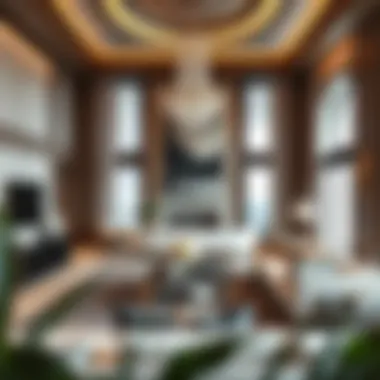Sotheby's Real Estate: Insights into Luxury Market Trends


Intro
Welcome to the intricate world of luxury real estate, where one name reigns supreme: Sotheby's. Founded on the principles of art and culture, Sotheby's Real Estate has carved out a niche that few can compete with. This article takes a closer look at Sotheby's position within the high-end property market, particularly in Dubai, a city known for its opulence and architectural marvels.
We will explore key aspects such as current market dynamics, significant historical trends, and future predictions that shape the luxury property landscape. Moreover, we will scrutinize Sotheby's portfolio of exclusive listings while considering how their unique approach to transactions serves the sophisticated buyer or investor. With a spotlight on notable sales and the brand's ongoing adaptation to shifting market conditions, this in-depth exploration promises to shed light on why Sotheby’s remains a pivotal player in the realm of luxury real estate.
Market Trends and Insights
Understanding the pulse of the real estate market is crucial, especially in a dynamic environment like Dubai. The luxury sector, particular to this region, has seen fluctuations fueled by global economic events, local developments, and changing buyer preferences. Here’s a closer look at the current market analysis and the trajectory that history and predictions suggest.
Current Market Analysis
Dubai's luxury property market is a melting pot of lavish residences, from ultra-modern high-rises to sprawling villas with views of the Arabian Gulf. Currently, the market is experiencing a resurgence, driven in part by the easing of international travel restrictions post-pandemic and Dubai's strategic initiatives to attract foreign investments.
Key data points include:
- Average sales prices for luxury properties have risen by approximately 15% over the past year.
- New developments like the Dubai Creek Harbour are drawing significant buyer interest.
- The demand from expatriates continues to bolster the high-end segment, as more individuals seek permanent residences in this urban paradise.
In this context, Sotheby’s boasts a portfolio that highlights both the exclusivity and diversity of offerings, catering to a clientele that demands nothing but the best.
Historical Trends and Future Predictions
Historically, the luxury market in Dubai has gone through cycles of boom and correction. Teetering on the edge of global events, both economic and political, this market has shown resilience. From a post-2008 recovery to the vibrant peak observed just before the pandemic, the real estate sector has adapted remarkably.
Looking forward, experts predict a continued upward trajectory for luxury listings. Factors driving this forecast include:
- Infrastructure developments such as the Expo 2020 legacy that promises new attractions and amenities.
- Sustainability trends pushing for green buildings, with many developers transitioning to eco-friendly design principles.
- Proactive policies undertaken by the UAE government to enhance real estate transparency and encourage investments.
"The market is not just recovering; it is evolving, creating new opportunities for savvy buyers and investors alike."
These evolving trends ensure that Sotheby’s is not merely riding the wave but also actively shaping it to benefit clients who seek the crème de la crème of properties.
Property Listings and Comparisons
With an impressive selection of high-end listings, Sotheby's offers a spectrum of options tailored to varied tastes and budgets. This section will evaluate Sotheby’s luxury properties, as well as explore any viable options that blend quality with affordability.
Luxury Properties Overview
Sotheby's Real Estate is notoriously known for curating some of the most exquisite properties on the market. Their listings often include:
- Penthouses in skyscrapers overlooking the iconic Palm Jumeirah.
- Private villas in gated communities with state-of-the-art amenities.
- Heritage properties that offer a touch of Dubai’s rich history in architecture.
Every property listed carries the mark of excellence, stamped with Sotheby’s meticulous standard of quality and service. Each listing tells a story of opulence, be it through breathtaking designs or unparalleled locations.
Affordable Housing Options
While Sotheby's is primarily synonymous with luxury, they recognize the growing demand for a range of property types in the market. Though their central focus remains on high-end offerings, there are emerging opportunities within the broader market that appeal to those seeking value for their investment.
Some aspects to consider include:
- New developments by reputable developers that allow entry into desirable areas at a relatively lower price point.
- Shared ownership models or leasehold options making high-end living more accessible.
Understanding Sotheby's Real Estate
Understanding Sotheby’s Real Estate is crucial for anyone looking to immerse themselves in the luxury property market. This section will explore the sophisticated branding and historical foundations that have shaped the company into a global leader in this niche industry. By analyzing Sotheby’s trajectory from auction house to major real estate player, we can appreciate the depth of its market knowledge and the reputation for excellence it has cultivated over the years.
The Origins of Sotheby's
Sotheby’s began its journey in 1744, founded in London as a book auctioneer by Samuel Baker. It was a humble start, far from today’s glamorous real estate empire. Fast forward to the 20th century, and Sotheby’s had established itself as a titan in the art auction sphere. This transition wasn’t merely about expanding their portfolio; it was about intertwining art and elegance with every transaction.
The move into real estate came as a natural evolution in 1976 when the company began to incorporate properties into their auction catalog, blending luxury living with high-end art. They capitalized on their reputation for excellence in sales, leading to a remarkable growth trajectory. The ability to create a seamless experience between buying fine art and exclusive properties has been a cornerstone of Sotheby’s approach. This synergy highlights their understanding of affluence and the finer things in life, setting the stage for a clientele that expects nothing less than supreme quality.
Evolution into Real Estate
As the luxury market began to thrive, Sotheby's transitioned to focus more on real estate, leveraging its global brands and esteemed reputation. The formal launch of Sotheby’s International Realty in 1976 marked a pivotal point, allowing the company to reach beyond auctions into the real estate industry on a grand scale.
With over 1,000 offices in numerous countries, Sotheby's now boasts a presence that speaks volumes about its adaptability and commitment. The brand didn’t just enter the real estate market; it transformed it. Sotheby’s auctions have always catered to high-net-worth individuals seeking exclusive assets, whether that be art, jewelry, or luxury properties. The company understood that real estate, much like fine art, requires a nuanced approach to marketing, negotiation, and service.
It is this evolution that has allowed Sotheby’s to stand out in an increasingly crowded market. The brand embodies the essence of high society, appealing to sophisticated investors wanting more than just property. The focus on bespoke experiences in luxury real estate aligns perfectly with the expectations of their affluent clients, highlighting the company’s unique position in the market.
“Sotheby’s Real Estate integrates artistry with architecture, creating a unique narrative for every property.”
Through all these transitions, Sotheby's has maintained its core values of quality and trust. Their historical roots still resonate in how they conduct themselves today—always aiming to provide clients with unparalleled service and luxurious options. The distinctiveness that Sotheby's brings to the table emphasizes its importance as a leading figure in the luxury real estate sector.
Core Values and Business Philosophy
In the realm of luxury real estate, a company’s core values and underlying business philosophy serve as the foundation on which its reputation and success are built. Sotheby’s Real Estate stands out not just for the high-end properties it markets but also for the ethos that governs its operations. This section delves into key elements such as a commitment to quality and a client-centric approach, which mold the experience for both buyers and sellers in the competitive world of luxury properties.


Commitment to Quality
At Sotheby’s, commitment to quality isn’t just a statement; it’s a way of life. The brand meticulously curates its listings, ensuring that each property reflects not only exceptional craftsmanship but also the lifestyle aspirations of its clientele. From the architectural integrity of a villa in Dubai’s Palm Jumeirah to the discreet elegance of an abode in London, every listing embodies a standard that sets Sotheby’s apart.
Why does quality matter? Simply put, it reassures clients that they are investing in a property that will maintain its value over time. Luxury buyers are often discerning, looking for something that transcends bricks and mortar. This promise of quality reassures them that they are making an astute investment.
Moreover, quality assurance extends to the customer service experience. The agents at Sotheby’s aren’t merely salespeople; they are seasoned professionals with in-depth market knowledge. Their ability to navigate the nuances of luxury real estate transactions fosters trust. In a landscape where the stakes are high, such attentiveness can be the difference between a satisfactory sale and a resounding success.
Client-Centric Approach
The beauty of Sotheby’s Real Estate lies in its client-centric approach. Here, it’s not about pushing properties; it’s about understanding individual needs and preferences. Each client is unique, and this philosophy is reflected in the way Sotheby’s tailors its services.
Factors influencing this approach include:
- Listening: Effective communication is the first step to identifying what a client truly desires. Agents spend quality time understanding their clients’ visions.
- Personalized Solutions: Whether it's a beachfront property or a metropolitan loft, Sotheby’s takes the time to personalize the search process. Clients receive listings that align with their specific criteria.
- Post-Transaction Support: The relationship doesn’t end once the sale closes. Agents often maintain connections, providing valuable insights about property management or investment opportunities.
"A satisfied client becomes a lifelong advocate; in luxury real estate, word-of-mouth is king."
This profound commitment to client satisfaction ensures that individuals feel more than just buyers; they're partners in a journey. The dedication to creating lasting relationships has paved the way for Sotheby’s to thrive, even in fluctuating markets.
Sotheby's Market Presence
Sotheby's presence in the luxury real estate market has not just been a mere footnote; it echoes with a compelling resonance that speaks volumes about its influence. As a marquee name, the brand is synonymous with high-end properties and distinguished service. This presence is critical for numerous reasons, particularly in how it shapes both perception and reality within this niche of the real estate sector.
A notable consequence of Sotheby's market presence is its ability to set trends. When missing a buyer for a remarkable villa in Dubai or a penthouse in New York, suddenly, the market seems to feel the ripple. This brand, with its decades of experience, has established a brand equity that cannot be easily replicated. The mission of Sotheby's goes beyond improving profits; it serves as a barometer for luxury lifestyles, ensuring that clients not only buy property but invest in a lifestyle.
Global Reach
The vast global reach of Sotheby’s Real Estate underscores its commitment to serving an international clientele. With offices sprawled across continents such as North America, Europe, and Asia, the company's footprint allows it to tap into various markets in ways that few others can manage. This transnational approach means that properties listed with Sotheby’s benefit from exposure to affluent buyers regardless of their geographical location.
For example, a lavish estate in the south of France could attract attention from potential buyers in Asia simply through the Sotheby’s network. The company effectively leverages its brand to showcase listings in prime markets like Hong Kong, Paris, and Beverly Hills, thus amplifying visibility whether you are eyeing a cozy beachfront cottage or a historic townhouse.
"With Sotheby’s, buyers find not just a broker, but a global ambassador for luxury real estate."
Key Markets and Partnerships
To further solidify its dominance, Sotheby’s has strategically established key partnerships that enhance its offerings and expand its reach. Collaborations with local real estate agencies around the world sharpen its edge; they work together to ensure that local insights are combined with global exposure.
In markets like Dubai, partnerships with elite developers play a pivotal role. Not only do they showcase the latest and most unique properties, but they also provide insights into emerging real estate trends. For instance, collaboration with firms specializing in sustainable building practices highlights the industry shift toward eco-friendly developments, attracting investors who prioritize sustainability.
In summary, Sotheby's market presence is not just about being well-known; it's about being influential. From its global reach that transcends boundaries to the shrewd market partnerships that enhance its offerings, Sotheby’s has managed to carve a unique space for itself within luxury real estate, thereby making it an essential player for investors, realtors, homebuyers, and developers alike.
Luxury Real Estate Listings
Luxury real estate listings hold a pivotal position in understanding Sotheby's influence in the high-end property market. They not only showcase the diverse range of exquisite homes but also reflect the aspirations and lifestyle choices of affluent individuals. The luxury sector represents a unique facet of real estate, where properties are often much more than mere shelter; they are symbols of status, investment, and lifestyle.
Factors to consider when diving into luxury real estate listings include:
- Prime Locations: Locations play a significant role in the valuation of luxury properties. Listings in exclusive neighborhoods, proximity to cultural landmarks, and stunning waterfronts often command a premium price. For instance, a villa in Palm Jumeirah is not just a home; it is a statement of luxury living.
- Architectural Significance: Unique architectural designs attract buyers seeking something distinctive. Properties designed by renowned architects can elevate listings. For example, a modernist villa incorporating sustainable design elements could stand out against traditional options, appealing to environmentally conscious buyers.
- Amenities and Features: High-end properties usually have a host of luxury amenities, from infinity pools to home theaters, which drastically affect their attraction. Listings that highlight unique features, like a spa center or a private cinema, tend to overwhelm less-equipped offerings in a competitive market.
- Market Trends: Understanding current market conditions is crucial for potential buyers and investors. Economic indicators, consumer sentiment, and demographic shifts can drastically change the landscape. Listings that reflect current trends, like eco-friendly homes or tech-integrated living spaces, may present golden opportunities.
"Investing in luxury real estate isn’t just about the property; it’s about the whole experience and lifestyle it represents."
In this segment, we will explore notable properties and unique selling propositions that Sotheby's promotes, effectively capturing the imagination of discerning clients who seek not just homes, but the embodiment of their aspirations.
Sotheby's Auctions: An Overview
Sotheby's auctions hold a pivotal position within the realm of luxury real estate, merging art with property and cultivating a unique atmosphere of exclusivity. The auction process sets Sotheby's apart from traditional real estate transactions, representing a sophisticated option for both sellers and buyers seeking high-valued assets. Engaging in an auction can lead to significant benefits, including faster sales, the potential for multiple bidders driving up prices, and the opportunity to capture buyer interest through a carefully crafted showcasing of properties.
Mechanics of Real Estate Auctions
Understanding the mechanics of real estate auctions is crucial for anyone looking to navigate this distinctive process. At its core, the auction experience involves several key steps:
- Pre-Auction Preparation: Before an auction date, Sotheby's engages with sellers to prepare properties for the auction. This may include professional staging, ensuring the property is in peak condition, and gathering necessary paperwork that verifies ownership and property details.
- Marketing the Auction: Sotheby's invests in high-end marketing strategies. They utilize digital platforms, social media, and traditional advertising to create buzz around the auction. By showcasing high-resolution images and virtual tours, they attract a keen clientele who appreciate fine living.
- Conducting the Auction: On the day of the auction, bidders present their bids either in person or through digital platforms. Auctioneers, with an innate talent for persuasive communication, highlight the best features of the properties as the bidding unfolds. A live auction can create an electrifying atmosphere, with competition often intensifying as buyers aim to secure their dream property.
- Closing the Deal: Once the gavel falls, signaling the end of bidding, a contract is drawn up. The winning bidder typically places a deposit then and there, with full payment expected within a specified period. The entire process is designed to move quickly yet efficiently, reflecting the urgency and exclusivity tied to luxury properties.
"The auction method not only acts as a sales platform but also shapes the perception of a property’s value, adding an emotional dimension to the transaction."
Historical Significance and Achievements
Sotheby’s auctions are steeped in history, with a legacy that dates back over 275 years. The evolution from a traditional art auction house to a leader in luxury real estate is a testament to its adaptability and strategic growth. Historical achievements in Sotheby’s auction history include:
- Groundbreaking Sales: Sotheby’s has facilitated some of the most prestigious real estate sales globally, each reflecting innovative marketing strategies and expertise.
- Influential Clientele: From celebrities to business moguls, Sotheby’s has catered to a discerning group of clients, reinforcing its reputation as a trusted platform in luxury markets.
- Global Landmark Auctions: Auctions that have taken place in iconic venues around the world—such as New York, London, and Dubai—illustrate the house's ability to attract international attention.
These historical milestones highlight how Sotheby’s not only transformed the auction landscape but also contributed significantly to luxury real estate’s mystique and allure. Today, participating in a Sotheby’s auction is considered an elite experience, whether as a buyer seeking a unique property or as a seller looking to maximize value.
Marketing Strategies
Exploring the marketing strategies employed by Sotheby’s Real Estate is key to understanding how they maintain their prestigious position in the luxury market. In a domain where buyers often seek not just properties, but rather an experience and lifestyle, the methods of promoting listings become crucial. Sotheby's recognizes that they are selling more than just a house; they are marketing a unique way of life, a narrative that resonates with discerning buyers.
Utilizing Digital Media


In today’s fast-paced environment, digital media plays a pivotal role in marketing luxury real estate. Sotheby’s has adeptly adopted cutting-edge technology to enhance their visibility and client engagement. They employ an array of online platforms including their own website, social media channels, and high-definition virtual tours. This digital presence allows potential buyers to experience properties from the comfort of home, an especially significant advantage during uncertain times.
Moreover, listings are often showcased through stunning photography and immersive videos. This is not just about aesthetics; it’s about storytelling. Each property is presented in a way that captivates potential buyers, inviting them into a world that enhances the allure of luxury. This narrative aspect drives engagement, ensuring that prospective clients form a connection before even stepping through the door.
"Harnessing the power of digital media is not just an option anymore; it’s a necessity in the luxury real estate market."
Sotheby’s also capitalizes on targeted online advertising, utilizing data analytics to understand potential buyers’ preferences. This insight allows for tailored advertisements that speak directly to the desires and lifestyles of high-net-worth individuals, making every marketing dollar work smarter.
Personalized Client Engagement
Sotheby’s commitment to creating a personalized experience for each client is at the heart of their marketing strategy. Recognizing that the luxury real estate market is driven by individual desires and aspirations, they focus on building lasting relationships rather than merely closing transactions.
The process often begins with understanding each client's specific preferences. Whether through in-person meetings or digital communication, Sotheby’s agents take the time to grasp the unique tastes, needs, and ambitions of their clients. This foundational understanding enables them to tailor property selections that resonate with the buyer’s vision.
Furthermore, continuous follow-ups and check-ins post-purchase demonstrate genuine care. It allows for adjustment of future recommendations based on evolving needs. This commitment to engagement fosters trust; clients are likely to recommend Sotheby's to their network, leading to referral business that is invaluable in the luxury market.
Achieving personalization may also involve niche marketing strategies. By utilizing data, Sotheby’s can segment their audience and deploy marketing campaigns that are relevant to specific buyer profiles, enhancing the effectiveness of their outreach.
Investment Opportunities through Sotheby's
Investment in real estate is often seen as both a means of economic growth and a strategy for wealth preservation. In the context of Sotheby's, the significance of exploring investment opportunities cannot be overstated. With its rich heritage and established credibility in luxury real estate, Sotheby's presents a unique platform for discerning investors looking to capitalize on high-end listings and affluent market trends.
When talking about investment opportunities through Sotheby's, it's important to consider several specific elements:
- Expertise in High-End Markets: Sotheby's has a pronounced presence in the luxury property market, particularly in global hotspots like Dubai. Their agents possess an in-depth understanding of these regions, aiding clients in making informed decisions.
- Exclusive Listings: Sotheby’s accesses prestigious properties that are often off-market or known only through selected channels. Such exclusivity tends to highlight the value of these properties, leading to a more resilient investment.
- Networking Opportunities: The Sotheby’s brand opens doors to a network of affluent buyers and investors. This can lead to potential partnerships or co-investing opportunities that may not be available through conventional real estate avenues.
However, with these benefits come considerations that potential investors shouldn't overlook:
- Market Volatility: The luxury market can be unpredictable. Various factors—including economic conditions, governmental policies, and changes in consumer behavior—can influence property values. Investors must remain vigilant about market trends.
- Investment Duration: Real estate is generally a long-term investment. For individuals seeking quick profits, the luxury market's longer sales cycles might pose a challenge.
- Maintenance and Management Costs: High-end properties often come with significant upkeep. Understanding the ongoing costs associated with maintaining luxury real estate is important to avoid unexpected financial strain.
Analyzing Market Trends in Dubai
Dubai’s real estate market is a gem that attracts global investors, boasting substantial returns and a vibrant lifestyle. To fully comprehend its potential, it's vital to analyze current market trends.
- Demand for Luxury Properties: The trajectory has been upward. Factors like the Expo 2020, advancements in infrastructure, and an expat-friendly environment have led to an influx of individuals seeking luxury living.
- Evolving Buyer Demographics: The buyer base for luxury properties has diversified significantly, bringing in high-net-worth individuals from various regions. Understanding these demographics helps in identifying where to find lucrative investment opportunities.
- Regulatory Changes: Recent governmental initiatives aimed at attracting foreign investment have offered a safety net for foreign buyers, thus fueling growth in residential and commercial sectors.
These trends indicate a well-rounded environment for investors seeking to venture into Dubai’s luxury market.
Identifying High-Potential Properties
Finding high-potential properties is akin to searching for a needle in a haystack, but with Sotheby’s expertise, investors have the upper hand. Recognizing the characteristics of promising investments becomes key to amplifying returns.
- Location Significance: Properties in prime locations—near waterfronts, tourist hotspots, or cultural landmarks—often appreciate better over time. Analyzing local attractions can spotlight lucrative options.
- Architectural Uniqueness: Homes that feature distinctive architectural designs draw buyers' attention. Whether modern or classic, unique aesthetics can enhance property value significantly.
- Sustainable Features: Increasingly, buyers are looking for eco-friendly homes. Properties equipped with sustainable features or located in green communities appeal to a new wave of investors who prioritize environmental impact.
In sum, identifying high-potential properties requires an acute awareness of market dynamics, buyer preferences, and geographic significance. By leveraging Sotheby’s extensive market knowledge, investors can pinpoint gems within the luxury real estate sector that are likely to yield solid returns well into the future.
"Understanding the luxury real estate landscape is not just about the buildings but also about the evolving trends and buyer interests that shape the market's future."
By tapping into Sotheby's unique position in this arena, investors can enhance their portfolios with choices that not only boast immediate charm but promise lasting value.
Challenges in the Luxury Market
The luxury real estate market, while brimming with potential and allure, is not without its fair share of challenges. It’s a landscape characterized by high stakes, where a misstep can lead to significant financial losses. Understanding these challenges is essential for anyone involved in this arena—be it investors, realtors, or developers. It can navigate the subtle nuances of the industry and make informed decisions that enhance their chances of success.
Economic Influences
The economic climate plays a pivotal role in shaping the luxury property market. Factors such as fluctuating interest rates, inflation, and economic growth— or lack thereof—can drastically affect buyer behavior. For instance, during times of economic uncertainty, prospective buyers may hesitate, leading to slower sales cycles. A recent example is the COVID-19 pandemic, which prompted many to re-evaluate their financial situations, causing a temporary lull in luxury sales.
- Consumer Confidence: The luxury market thrives on confidence. When consumer confidence dips, high-net-worth individuals may reassess their spending priorities. Luxury properties often get sidelined in favor of more liquid investments.
- International Markets: Economic influences aren’t confined to a single nation. Global economic trends, especially in influential markets like China and the U.S., can have ripple effects on luxury real estate. A downturn in one country can result in reduced foreign investment in another.
Economic forecasts play an important role for investors. Keeping an ear to the ground can help one anticipate potential economic shifts, thus allowing for strategically timed purchases or sales in the luxury market.
"Economic indicators are like the weather forecast for the real estate market - it pays to pay attention to them."
Regulatory Challenges
Navigating the maze of regulations surrounding luxury real estate can be as daunting as it is essential. Different jurisdictions have varying laws regarding property purchases, zoning regulations, and taxes, which can complicate transactions. Understanding these regulations is crucial not only for compliance but also for maximizing investment returns.
- Foreign Ownership Laws: Many regions have specific rules governing foreign ownership of property. In some locations, foreign investors are limited, while in others, there may be additional taxes applicable to non-residents. This aspect can deter potential buyers, impacting market liquidity.
- Environmental Regulations: With growing concerns over sustainability, more stringent environmental regulations are becoming commonplace. These can affect property development timelines, operational costs, and even the potential for future sales.
- Taxation: Luxury property buyers often face hefty taxes, including property taxes and stamp duties. A sudden increase in these taxes can deter purchases, especially if buyers feel that the additional costs are unjustified.
Case Studies of Successful Transactions
Case studies of successful transactions in Sotheby's Real Estate offer a compelling lens through which stakeholders can gauge the firm's effectiveness and adaptability in the competitive luxury market. These case studies not only highlight the successful sales made but also reveal insights into the tactics employed, the challenges faced, and the lessons learned along the way.
Real estate transactions, particularly of high-value properties through Sotheby's, serve as a barometer for the broader market trends and can illuminate potential future movements. For investors and realtors, understanding these case studies provides a strategic advantage and informs their decision-making processes.
High-Profile Sales and Acquisitions


Sotheby's Real Estate has been known for its role in several high-profile sales and acquisitions that have caught the attention of the real estate community. Take, for instance, the sale of a penthouse in New York City that commanded a staggering price, setting a record at the time. This particular transaction involved meticulous marketing strategies, a network of affluent brokers, and a deep understanding of the luxury buyer's psyche.
The property, with unparalleled views and top-tier finishes, was more than a mere residence; it was a statement piece for the buyer. Sotheby's leverage their extensive reach to showcase such properties on a global stage, through engaging digital platforms and exclusive invitation-only showings. It's not just about the property; it's about creating an experience that resonates with high-net-worth individuals looking for more than just a house.
Moreover, another notable case includes the acquisition of an estate in California’s wine country, which demonstrated Sotheby's ability to tap into niche markets. This not only broadened their portfolio but also invited serious investors with an eye for unique properties that hold significant value beyond the bricks and mortar.
Lessons Learned from Notable Cases
The various case studies also shed light on valuable lessons from notable transactions. One critical lesson is the importance of local knowledge in a global market. Sotheby's agents are often well-versed in the nuances of their local markets, enabling them to provide informed advice to potential buyers and sellers.
For example, understanding local zoning regulations and historical context can make or break a deal for buyers eyeing properties with redevelopment potential.
Another lesson is adaptability. During downturns, market conditions can shift rapidly, and successful transactions depend on the ability of the agents to pivot strategies.
A case that stands out involved adjusting pricing strategies mid-campaign to attract buyers in a cooling market. This adaptive approach not only salvaged sales but also helped build trust and credibility within the client base.
In summary, analyzing these case studies reveals a wealth of knowledge for various stakeholders in the luxury real estate market. The buying and selling of high-profile properties through Sotheby's serves as a testament to their expertise, backed by concrete examples that show how thoughtful strategies and informed decision-making contribute to their continued success.
Sotheby’s Adaptation to Market Changes
In the ever-evolving realm of real estate, adaptability is more than just a skill; it’s a necessity. For Sotheby's, a name synonymous with luxury and high-stakes transactions, adjusting to market changes is critical for maintaining its esteemed position in the global marketplace. As consumer preferences shift and technology advances, understanding and responding to these dynamics becomes pivotal.
Innovations in Real Estate Services
Sotheby’s Real Estate has remained at the forefront of innovation. They’ve leveraged technology to enhance their service offering. With tools like virtual reality tours, potential buyers can now explore high-end properties from the comfort of their homes. This innovation not only saves time but also widens the market reach, allowing international buyers to envisage their future homes without the need for immediate travel.
Moreover, the utilization of big data analytics enables Sotheby’s to gain insights into market trends and buyer behavior. This data-driven approach allows them to fine-tune marketing strategies, targeting potential buyers more precisely. When Sotheby’s understands what buyers are looking for, be it luxurious amenities or specific architectural styles, they can tailor their listings to mirror these demands.
Additionally, Sotheby's has adoped new technologies such as blockchain for secure and transparent transactions. This ensures that buyers can trust the integrity of their purchases, an essential factor in the high-stakes luxury market. By putting technology at the core of its services, Sotheby’s continues to lead in a competitive landscape.
Embracing Sustainability
Another noteworthy aspect of Sotheby’s adaptation strategy is its commitment to sustainability. In today’s market, eco-friendliness is not just a buzzword; it’s a demand. Buyers, especially younger generations, are increasingly looking for properties that reflect their values.
Sotheby’s response to this has been to promote and partner with developments that emphasize green building practices. Properties with energy-efficient systems or those made from sustainable materials are becoming more sought after. Not only does this cater to a growing demographic of environmentally-conscious buyers, it also positions Sotheby’s as a responsible leader in the market.
In addition, they are integrating sustainability into their marketing narrative. By highlighting features such as solar panel installations or sustainable landscaping, Sotheby’s appeals to buyers who prioritize sustainable living.
"Incorporating sustainability within luxury real estate not only meets buyer demands but also pioneers a new standard in elite living."
These two strategies—technological innovation and a commitment to sustainability—illustrate how Sotheby's is not just responding to market shifts; it is anticipating them. By remaining ahead of the curve, they reinforce their status as a premier luxury real estate firm capable of satisfying the needs of the modern buyer.
Whether it’s through embracing digital services or prioritizing eco-friendly properties, Sotheby’s approach will undoubtedly influence the future landscape of luxury real estate, ensuring they remain a prominent force in the industry.
Consumer Perception of Sotheby's Brand
In the competitive arena of luxury real estate, how buyers and investors perceive a brand can be a game changer, particularly for Sotheby’s. The perception isn’t just a side note; it weaves into the fabric of marketing strategies and client relationships. Each interaction, whether browsing a listing or attending an open house, carves out an impression that can heavily sway potential buyers in their decision-making process.
One of the core elements that influence consumer perception about Sotheby’s is its longstanding legacy in the auction world. Known originally for art, it has leveraged this history to create a brand synonymous with prestige and exclusivity in real estate. Buyers are often looking for more than just a property; they seek a lifestyle and an image that aligns with their aspirations. And Sotheby’s has mastered the art of marketing not just homes, but dreams.
Brand Recognition and Trust
The recognition of Sotheby’s brand within the luxury market is elevated due to its heritage and reputation. The trust factor plays a vital role here. When a buyer selects Sotheby's, they are not merely purchasing a property; they are buying into a promise of quality and excellence.
- Heritage: Sotheby's has been in the business for centuries. This legacy fosters an inherent trust. Buyers often feel more confident working with a company that has weathered the test of time.
- Expertise: With a multitude of specialists in various fields within the real estate sector, Sotheby’s houses knowledge that is impressive. This expertise serves as a safety net for buyers who may feel overwhelmed in high-stakes transactions.
Moreover, recent surveys suggest that clients consistently rate Sotheby’s higher in terms of customer satisfaction when compared to its competitors. This can largely be attributed to their approach and commitment to understanding client needs.
Differentiating Factors from Competitors
Standing out in a crowded market requires more than a polished image; it necessitates unique offerings and a tailored approach. Sotheby’s differentiates itself through a few key strategies:
- Personalized Service: Every client is met with a tailored approach, focusing on individual preferences. Unlike larger corporates where one size fits all, Sotheby’s emphasizes unique experiences.
- Niche Market Focus: The brand's focus on high-end luxury properties attracts a certain clientele who are looking for exclusivity. This refined specialization sets it apart from broader real estate firms.
- Global Network: Sotheby’s has established connections around the globe, enabling them to provide clients with unique opportunities that others cannot access. This network builds a platform for expansive reach while still offering localized services.
Sotheby's blends tradition with innovation, creating an aura of sophistication that continues to attract discerning clients.
Understanding consumer perception of Sotheby's brand isn't just important; it’s fundamental to the company's success and endurance in an ever-changing luxury market. That perception keeps buyers coming, knowing they are dealing with an institution that truly understands high stakes and high expectations.
Ending: The Future of Sotheby's Real Estate
As the world of real estate undergoes constant evolution, understanding the future of Sotheby’s within this landscape is vital. The luxury property market, particularly in regions like Dubai, presents both challenges and opportunities that this fine real estate company must navigate carefully. This section brings into focus the importance of looking ahead and examining the strategic frameworks that will shape Sotheby’s operations and its adaptation to swift market changes.
Forecasting market trends becomes more than just a predictive tool; it’s an essential roadmap for stakeholders. By understanding the fluctuations in buyer preferences, geopolitical ramifications, and economic conditions, Sotheby's can tailor its offerings and marketing strategies accordingly. For example, the growing interest in eco-friendly properties highlights the necessity for luxury listings that meet sustainability criteria. Reports from sources such as Britannica indicate that environmentally conscious investments are on the rise; thus, this could very well become a focal point for Sotheby’s future portfolio.
Moreover, the shift in demographics with younger buyers entering the market means real estate strategies must adapt as tastes change. The shift from traditional buying methods to more digital experiences is reshaping how potential buyers interact with properties. This realignment points to an evolving landscape where Sotheby’s needs to engage clients through innovative digital platforms that enhance the home-buying experience.
Another critical component is the long-term strategic goals that Sotheby’s must pursue. These goals not only guide the aesthetic and operational approach but also ensure alignment with the future demands of the market.
Long-Term Strategic Goals
When we talk about long-term goals for Sotheby’s Real Estate, it’s about laying down the groundwork for sustained growth amid a shifting competitive landscape. This includes:
- Diversifying Luxury Offerings: Expanding beyond traditional luxury markets by offering properties at various price points without diluting the brand’s essence.
- Using Technology to Connect: Investing in augmented reality and virtual tours can create immersive experiences that resonate with a tech-savvy audience.
- Building Community Relationships: Establishing local partnerships can boost brand presence and provide Sotheby’s with valuable market insights. Building local ties not only promotes listings but also fosters a community around the brand.
Ultimately, these strategic pursuits focus on remaining a coveted choice for investors, homebuyers, and even developers who recognize the promise of Sotheby’s brand integrity.















